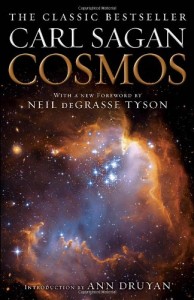By Carl Sagan. 1980.
About 15 billion years ago, the Big Bang occurred. This sent matter and energy expanding outward. For millions of years, there were no galaxies, no planets, no life. Hydrogen atoms were the only matter around, but most of the universe was void and empty. Very gradually, the hydrogen atoms coalesced into accumulations of gas, driven by gravity. When the pressure inside these spheres of hydrogen grew large enough, the hydrogen atoms fused together into helium atoms, and photons. A first generation of stars was born. Inside these stars, as the stars aged and consumed their nuclear fuel, they grew denser. This increased density allowed the creation of heavier elements: after helium, came lithium, then beryllium, then boron, then carbon, then nitrogen, then oxygen, all the way up to iron. The larger a star is, the faster it burns its nuclear fuel. Thus, these early supermassive stars were relatively short-lived; they had lifetimes of millions, rather than billions of years. When they died, they died spectacularly: they collapsed in on themselves quickly and then rebounded outward in a supernova, a titanic explosion more powerful than a trillion atom bombs. This had the effect of releasing the heavy elements. The process then repeated itself: mutually attracted by gravity, the atoms again drew together. But this time the gas and dust collected into disk-shaped clouds. Through collisions and time, the atoms organized themselves into a few large central globes of matter and smaller globes that circled the globes. In the smaller globes, there was not enough matter to trigger nuclear fusion, and they became not stars, but planets. One of these was a globe composed primarily of silicon and iron. A globe that some call Earth.
As the earth warmed and congealed, it released the methane, ammonia, water, and hydrogen gasses that been trapped within, forming the primitive atmosphere and the first oceans. Starlight light from the sun warmed the primeval Earth. Storms were driven lightning generated, and thunder. Volcanoes poured forth lava. These processes disrupted molecules of the primitive atmosphere; the fragments fell back together again into more and more complex forms. These dissolved in the early oceans. It was only because of the inpouring of energy from the sun and the geothermal energy being released by the primitive Earth that an increase in order was possible. Chemical evolution was underway. The oceans eventually reached the consistency of a warm, dilute soup. Molecules were organized, and complex chemical reactions driven, on the surface of clays. And one day a molecule arose that quite by accident was able to make crude copies of itself out of the other molecules of the broth. As time passed, more elaborate and more accurate self-replicating molecules arose. Those combinations best suited to further replication were favored by the sieve of natural selection. Those that copied better produced more copies. And the primitive oceanic broth gradually grew thin as it was consumed by and transformed into complex condensations of self-replicating organic molecules. Gradually, imperceptibly, life had begun.
Phospholipids evolved into single cells. Plants evolved, and life began to generate its own food, transforming sunlight into chemical energy, in a process called photosynthesis. One of the by-products of this process is oxygen, and the atmosphere began to become rich in oxygen. Sex was invented. This allowed a quick way to reshuffle genetic information, for the maximum possible advantage. Forms that were once free-living banded together to make a complex cell with specialized functions. Chemical receptors evolved and the Cosmos could taste and smell. One-celled organisms evolved into multicellular colonies, elaborating their various parts into specialized organ systems. Eyes and ears evolved and now the Cosmos could see and hear. Plants and animals moved from the oceans to the land. About 10,000 years ago, agriculture was invented, apparently independently, in seven different regions of the planet. This allowed division of labor and increased social stratification.

